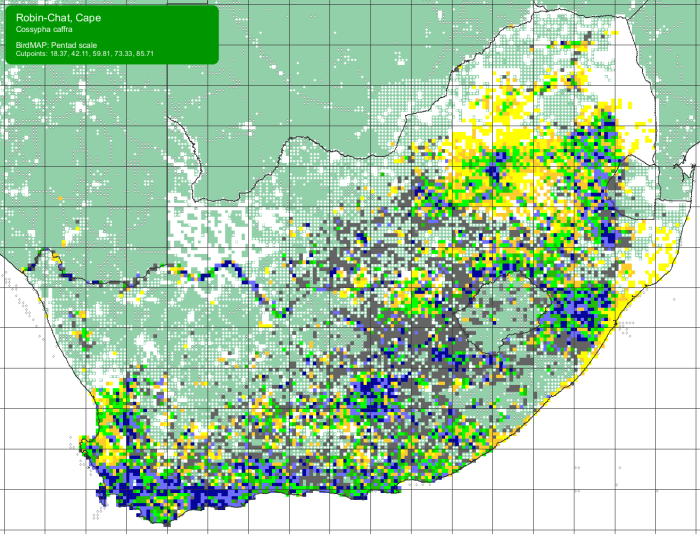Identification
The Cape Robin-Chat can be identified by its dark grey back, orange throat, white “eyebrows” and its orange rump and tail feathers. It has pale grey underparts and dark legs and feet. Males and females are alike.

Juvenile birds are browner with buff spotting and no distinct facial markings. They have dull buffy brown underparts with mottling on the chest. Their tails are rufous with grey feathers down the centre.

The Cape Robin-Chat has a wonderful melodious call consisting of a few phrases. They often mimic other birds too. Take a listen here.
Habitat
Cape Robin-Chats can be found in a wide variety of habitats, but they prefer areas with quite dense undergrowth and scattered trees, bushes, rocks or other structures to use for perching, along with surface water for drinking and bathing. They love suburban gardens and can become quite tame.


Distribution
Occurs in patches from southern Sudan to Kenya, eastern DRC and Tanzania, with the largest population in southern Africa. It occurs across most of South Africa as indicated by the SABAP2 map below. The blue and green squares are the areas with the highest reporting rates for Cape Robin-Chat.

Behaviour
The Cape Robin-Chat moves about singly with a hopping gait, and often perches in prominent positions. It regularly jerks up its tail in an upright position, almost as if standing to attention. When landing on a perch or on the ground it often flicks its wings and rapidly fans its tail. Cape Robin-Chats take a bath daily, so if you have a bird bath in your garden, keep an eye out for this water-loving bird.

They mainly eat insects and other invertebrates, supplemented with fruit and seeds plucked from bushes, trees or from the ground. They do a lot of foraging in leaf litter, flicking through plant debris in search of food.

The Cape Robin-Chat is a highly territorial and solitary nester. The male aggressively defends his territory against other males as well as other species, such as white-eyes, sunbirds and doves! The nest is built, usually by the female, by gathering a clump of material together and then she shuffles her body into the nest to form a cup shape. The nest is usually made out of bark fragments, twigs, dry grass, fern fronds, rootlets, dead leaves, moss and seed pods and lined with finer fibres.

Further resources
Species text from the first Southern African Bird Atlas Project (SABAP1), 1997.
Virtual Museum (BirdPix > Search VM > By Scientific or Common Name).
More common names: Gewone Janfrederik (Afrikaans); Ugaga (Xhosa); umBhekle (Zulu); Cossyphe du Cap (French); Kaprötel (German); Kaapse Lawaaimaker (Dutch).
Recommended citation format: Loftie-Eaton M and Daniel KA 2022. Cape Robin-Chat Cossypha caffra. Bird Feeder Project. Biodiversity and Development Institute. Available Online at http://thebdi.org/2022/03/08/cape-robin-chat-cossypha-caffra/

